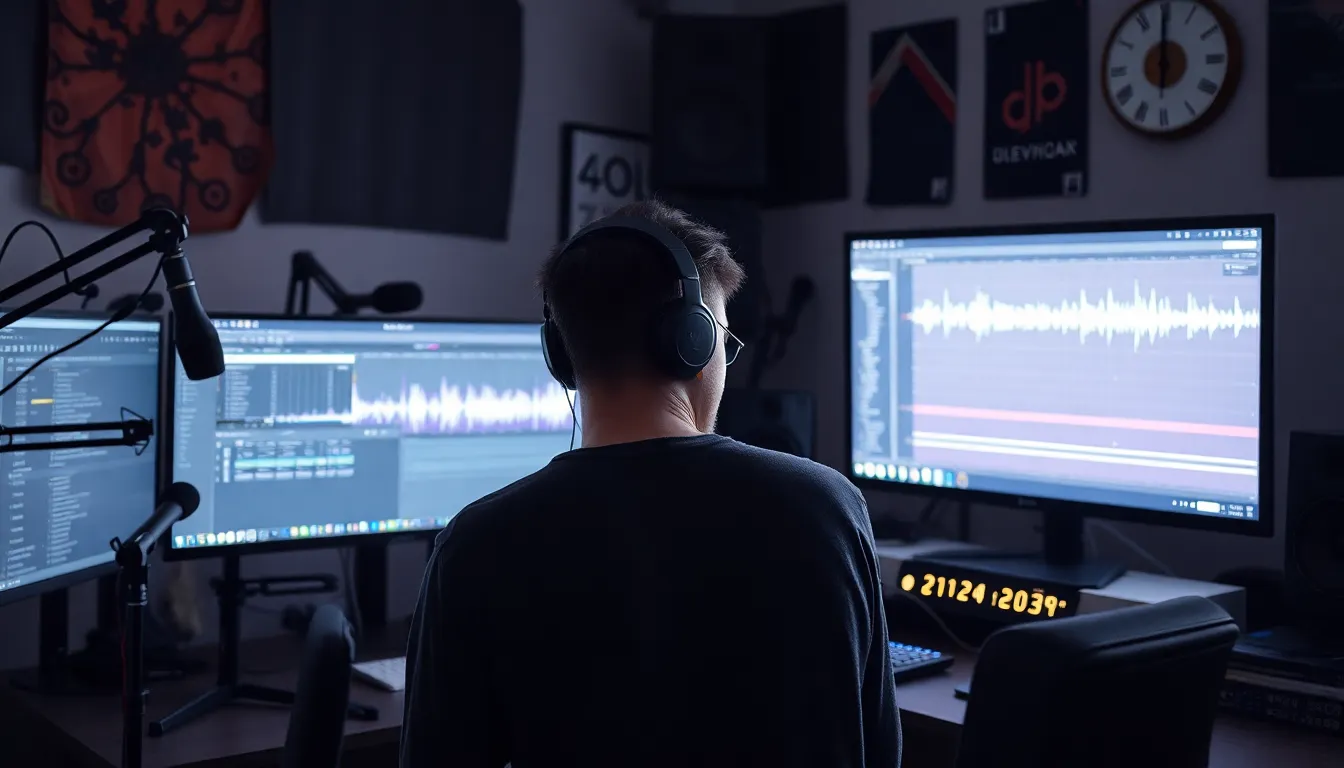In the immersive world of PC gaming, sound design often plays the unsung hero. While players might focus on graphics and gameplay mechanics, it’s the audio that sets the mood and pulls them deeper into the experience. Imagine a spine-chilling whisper echoing in a dark dungeon or the triumphant fanfare that greets a hard-earned victory. Without sound, games would just be a series of colorful pixels and frantic clicks.
Importance Of Sound Design In PC Games
Sound design plays a pivotal role in the gaming experience. While players often focus on visuals and gameplay mechanics, audio elements significantly influence immersion and engagement.
Enhancing Immersion
Immersion thrives on believable soundscapes. Background sounds, like rustling leaves or distant thunder, transport players into the game’s world. Realistic audio cues help players react authentically, enhancing their connection to the game. For instance, the sound of footsteps on different surfaces creates sensory variety that keeps players engaged. Without these auditory signals, the gaming experience feels flat and disconnected.
Creating Atmosphere
Atmosphere relies heavily on sound design. Eerie creaking sounds in horror games build tension, while upbeat music elevates excitement in action titles. These auditory elements set the emotional tone, guiding players through various experiences. A game’s environment often transforms with subtle sound alterations, like muffled noises during a stealth mission, deepening engagement. Effective sound design ensures players feel the weight of their actions and decisions, increasing their investment in the narrative.
Elements Of Sound Design

Sound design in PC gaming consists of various elements that work together to create an immersive experience. Key components include sound effects, music composition, and voice acting.
Sound Effects
Sound effects play a vital role in gameplay. They enhance actions, making them feel more impactful. For example, a gunfire sound might differ based on the weapon type, adding realism. Environmental sounds, such as rustling leaves or distant explosions, enrich the atmosphere. Designers use layered audio clips to create depth, ensuring every action resonates with the player. Different surfaces produce distinct footstep sounds, guiding players’ emotional responses during gameplay. Without these intricacies, the gaming experience would feel hollow and less engaging.
Music Composition
Music composition elevates the emotional tone of a game. Composers create soundtracks tailored to specific scenes or gameplay moments, reinforcing the narrative. For instance, a suspenseful score can heighten tension during crucial encounters. Dynamic music adjusts to player actions, enhancing immersion. Variations, such as tempo shifts, signal changes in gameplay scenarios, keeping players on edge. Themes resonate with characters, solidifying connections between the story and the player. Diverse musical styles contribute to the unique identity of each game, ensuring memorable experiences.
Voice Acting
Voice acting brings characters to life, allowing for richer storytelling. Skilled voice actors convey emotions, making dialogue believable and engaging. Character-specific voices enhance the game’s narrative, helping players form attachments. The pacing and tone of delivery affect the overall mood during critical scenes. Additionally, localized voice acting caters to diverse audiences, broadening reach. Quality voice performances ensure players feel invested in the game’s storyline, making each conversation impactful. Effective voice acting transforms dialogue into a powerful storytelling tool, enhancing the gaming experience significantly.
Techniques Used In PC Game Sound Design
Sound design in PC games utilizes various techniques to create immersive audio experiences. Two primary methods include field recording and synthesis and sampling.
Field Recording
Field recording captures real-world sounds, enhancing game environments with authentic audio. Designers use various recording devices to gather sounds from different locations, including urban settings, forests, or rural areas. Capturing these sounds provides a library of unique audio clips that contribute to the game’s atmosphere. For instance, footsteps on gravel or distant thunder build a realistic immersion that elevates gameplay. This technique allows sound designers to craft a distinctive auditory signature for each game world, creating a more engaging experience for players.
Synthesis and Sampling
Synthesis and sampling focus on generating and manipulating sounds using software and hardware. Sound designers utilize synthesizers to create unique audio elements that blend seamlessly into the game’s audio landscape. Sampling involves taking snippets of existing sounds and altering them to fit the game’s style, adding layers and complexity. Both methods enable sound designers to produce dynamic audio that reacts to player actions or narrative changes. Effective use of synthesis and sampling can lead to memorable soundscapes that resonate with players and enhance emotional engagement.
Challenges In PC Game Sound Design
PC game sound design presents numerous challenges that can affect the overall gaming experience. Addressing these issues requires careful consideration and execution.
Balancing Sound Levels
Balancing sound levels plays a critical role in ensuring players enjoy an immersive experience. Designers must adjust the volume of sound effects, music, and dialogue so they complement each other. When background music overshadows crucial voice lines, players may miss key narrative elements. In addition, environmental sounds should not drown out significant audio cues that enhance gameplay. Effective balance creates a harmonious audio landscape. Implementing techniques like mixing and mastering ensures sound quality meets industry standards. Testing across different scenarios allows sound designers to maintain a consistent audio experience that captivates players throughout their journey.
Adapting to Different Audio Hardware
Adapting to different audio hardware poses a significant challenge for sound designers. Various speakers, headphones, and sound cards produce distinct audio experiences. Consequently, designers must account for this diversity to maintain quality across all platforms. Listening tests on multiple devices help identify discrepancies in sound output. Creating adaptive audio systems allows games to modify audio settings based on the user’s hardware. This flexibility improves sound consistency and user experience. Additionally, delivering options for players to customize audio settings empowers them and enhances their immersion in the game world.
Future Trends In PC Game Sound Design
The landscape of PC game sound design continues to evolve, with emerging technologies shaping future trends.
Virtual Reality
Virtual reality transforms sound design by creating fully immersive audio experiences. Spatial audio techniques allow players to perceive sound from various directions and distances, enhancing realism. Positioning sounds accurately in a 3D space plays a crucial role in gameplay as it fosters deeper player engagement. Game designers now explore advanced audio tools, implementing binaural sound that simulates how humans hear in real life. This method increases the sensation of presence in virtual environments, drawing players further into the narrative. Developers integrate environmental cues, such as rustling leaves or distant thunder, promoting a more tactile experience as players navigate game worlds.
Adaptive Soundtracks
Adaptive soundtracks revolutionize the way music interacts with gameplay. Dynamic scores adjust based on player actions and in-game events, creating a reactive audio environment. Designers focus on integrating music transitions that seamlessly align with changes in gameplay intensity. Such soundtracks can heighten emotional engagement by reflecting the player’s journey and decision-making within the narrative. Implementing algorithmic changes to composition enables soundtracks to evolve with the storyline, enhancing immersion. Future designs emphasize personalized experiences, where soundtracks may shift according to individual player styles and preferences, tailoring the experience to each gamer.
Sound design is an essential pillar of PC gaming that elevates the player experience. It shapes the emotional landscape of a game and draws players into immersive worlds. From the chilling echoes of a haunted dungeon to the triumphant scores of victory, sound enriches gameplay in ways that visuals alone cannot achieve.
As technology evolves, the future of sound design promises even greater immersion through innovations like spatial audio and adaptive soundtracks. These advancements will continue to deepen player engagement and make every gaming session a uniquely memorable journey. Ultimately, the artistry of sound design is what transforms a simple game into a captivating adventure.



